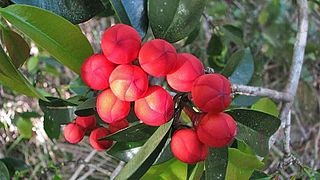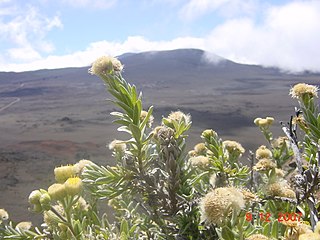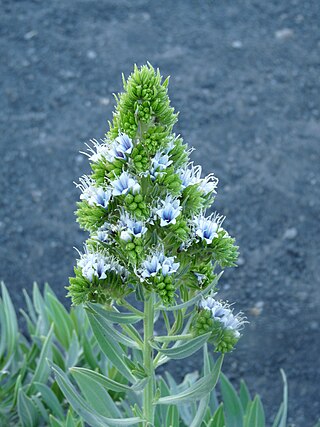Paranecepsia is a plant genus of the family Euphorbiaceae first described as a genus in 1976. It contains only one known species, Paranecepsia alchorneifolia, native to southeastern Africa.
Parodiodendron is a monotypic plant genus under the family Picrodendraceae, described as a genus in 1969. The sole species is Parodiodendron marginivillosum(Speg.) Hunz..

Symphonia globulifera, commonly known as boarwood, is a timber tree abundant in Central America, the Caribbean, South America and Africa. This plant is also used as a medicinal plant and ornamental plant.

Leucosidea sericea, commonly known as oldwood, is an evergreen tree or large shrub that grows in the highland regions of southern Africa. It is the sole species in the monotypic genus Leucosidea. The name oldwood may reflect the fact that the wood burns slowly, as if old and rotting; the gnarled, twisted trunks reinforce this impression.

Dipteryx charapilla is a little-known species of flowering plant in the family Fabaceae, a large to mid-sized tree growing along rivers in the rainforests of Brazil. and Peru.

Psiadia, commonly known as daisy trees, is a genus of mostly woody Asian and African plants in the tribe Astereae within the family Asteraceae. The genus is distributed throughout the Western Indian Ocean, with species reported from continental Eastern Africa, Madagascar, Mauritius, La Reunion, Rodrigues, the Comoro islands, as well as several of the smaller, uninhabited islands in the Mozambique Channel. Additional species are suspected on Socotra and Sri Lanka, but these have not been confirmed. Phylogenetic studies using DNA sequence data and biogeographic reconstruction using molecular dating have shown that the genus originated on the African mainland, and colonized Madagascar and the outlying islands in the Indian Ocean in several independent instances of overwater dispersal in the Miocene.
Garcinia afzelii is a species of small to medium tree in the family Clusiaceae. It is found in Cameroon, Central African Republic, Gabon and Guinea. It is sometimes called "bitter kola", but this name properly refers to G. kola.
Aubregrinia is a genus of plant in the family Sapotaceae first described as a genus in 1935.

Autranella is a genus of plant in family Sapotaceae described as a genus in 1917. It contains only one recognized species, Autranella congolensis, native to west-central Africa.
Bafodeya is a genus of plants in the family Chrysobalanaceae described in 1976.
Buchenavia hoehneana is a species of plant in the Combretaceae family. It is endemic to Brazil, found only in a few localities of the Atlantic Forest. It is threatened by habitat loss.

Kirkia is a genus of plant in family Kirkiaceae. It was previously placed in family Simaroubaceae, but was transferred into Kirkiaceae, together with Pleiokirkia, because these genera produce neither quassinoids nor limonoids.
Knema sericea is a species of plant in the family Myristicaceae. It is a tree endemic to Borneo.
Manilkara subsericea is a species of plant in the family Sapotaceae. It is endemic to Brazil, and threatened by habitat loss.
Monocyclanthus is a monotypic genus of flowering plants in the family Annonaceae containing the single species Monocyclanthus vignei. It is native to Ghana and Liberia. It is a rare plant of the understory of wet evergreen forest habitat.

Breynia retusa is a species of plant in the family Phyllanthaceae.

Xylopia africana is a species of plant in the Annonaceae family. It is found in west-central Africa. It is restricted to submontane and lower montane forests. It is threatened due to habitat loss by clearance of forest. It was first described as Melodorum africanum in 1862 by George Bentham.
Mallotus oppositifolius is a plant species in the genus Mallotus found in Africa and Madagascar.
Baccharis dioica is a North American species of shrubs in the family Asteraceae known by the common name broombush falsewillow. It is native to Florida, the Yucatán Peninsula, and the West Indies.

Echium vulcanorum is a species of flowering plants of the family Boraginaceae. The species is endemic to Cape Verde. It is listed as an endangered plant by the IUCN. The species was first described in 1935 by Auguste Chevalier. Its local name is língua-de-vaca, a name that may also refer to the related species Echium hypertropicum and Echium stenosiphon. The oil of its seeds contains γ-linolenic acid, and is used for medicinal and dietary purposes.









